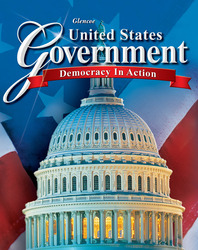United States Government: Democracy in ActionChapter 11:
The Federal Court SystemChapter Overviews[logo] Essential Question
How does the Constitution define the powers of the federal courts, and how are the various courts related to one another? Section 1 Powers of the Federal Courts
The United States judicial system has two parallel systems of courts: federal courts and state courts. The 50 state court systems derive from state constitutions and laws. The federal system consists of the Supreme Court at the top and lower federal courts established by Congress. In this dual-court system, state courts have jurisdiction over cases involving state law. Federal courts have jurisdiction in cases that involve U.S. laws, treaties with foreign nations, interpretations of the Constitution, bankruptcy, and maritime laws. The federal courts also hear cases if the parties involved are ambassadors, state governments, the federal government, or citizens of different states. Federal and state courts have concurrent jurisdiction in some civil cases. Section 2 Lower Federal Courts
Congress created two kinds of lower federal courts: constitutional courts set up under Article III, and legislative courts as spelled out in Article I. The constitutional courts include 94 district courts with original jurisdiction over civil and criminal federal trials. District courts utilize grand juries to hear charges and issue indictments, and petit juries to weigh evidence and render a verdict. Other Article III courts include the 13 federal courts of appeals. Twelve of these courts of appeals are located throughout the country's 12 judicial circuits and hear appeals from the district courts in their circuit as well as from territorial courts, the U.S. Tax Court, courts in the District of Columbia, and federal regulatory agencies. The thirteenth appellate court—the Court of Appeals for the Federal Circuit—has nationwide jurisdiction over appeals from the U.S. Court of International Trade, the U.S. Claims Court, and the U.S. Court of Veterans' Appeals. The legislative or Article I federal courts were created to help Congress exercise its powers. They include the U.S. Court of Federal Claims, a court with original jurisdiction that handles cases when someone sues the government. The U.S. Tax Court has original jurisdiction over federal tax cases. Territorial courts hear civil and criminal cases in the Virgin Islands, Guam, the Northern Mariana Islands, and Puerto Rico. The Court of Appeals for the Armed Forces hears appeals from military courts. The FISA court operates in secret and grants warrants to eavesdrop on citizens and foreigners suspected of terrorism. The president appoints all federal judges with the advice and consent of the Senate. Judges who are appointed to the constitutional courts—district courts, the courts of appeals, and the Supreme Court—serve for life. Section 3 The Supreme Court
The Supreme Court is the final authority in any case involving the Constitution, acts of Congress, and treaties with other nations. Most of its cases are appeals from lower federal district or appeals courts or state supreme courts, and it carefully chooses which cases it will hear. The Supreme Court also has original jurisdiction in cases involving representatives of foreign governments and certain cases in which a state is a party. The Supreme Court is comprised of nine justices: the chief justice and eight associate justices. Their duties have developed from laws, traditions, and as the needs of the nation have developed. Their main duty is to decide which cases to hear, decide the case itself, and issue an opinion explaining the decision. The justices are also distributed among the 12 judicial circuits and handle special requests for legal actions in their circuits. The president appoints the justices, who then must be approved by the Senate. Political considerations often affect a president's choice of a nominee to the Court. Presidents want someone with their own political beliefs to sit on the Court. The attorney general, the American Bar Association, interest groups, and even sitting justices advise the president on whom to nominate to the Court.  | 
















